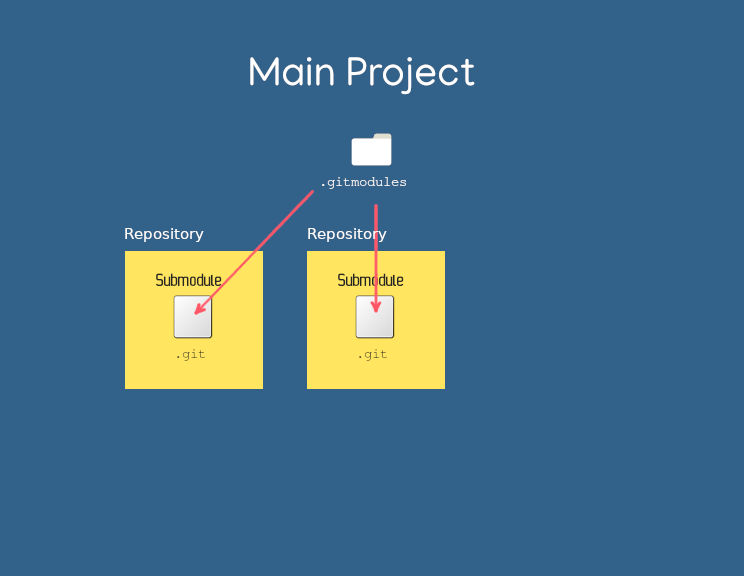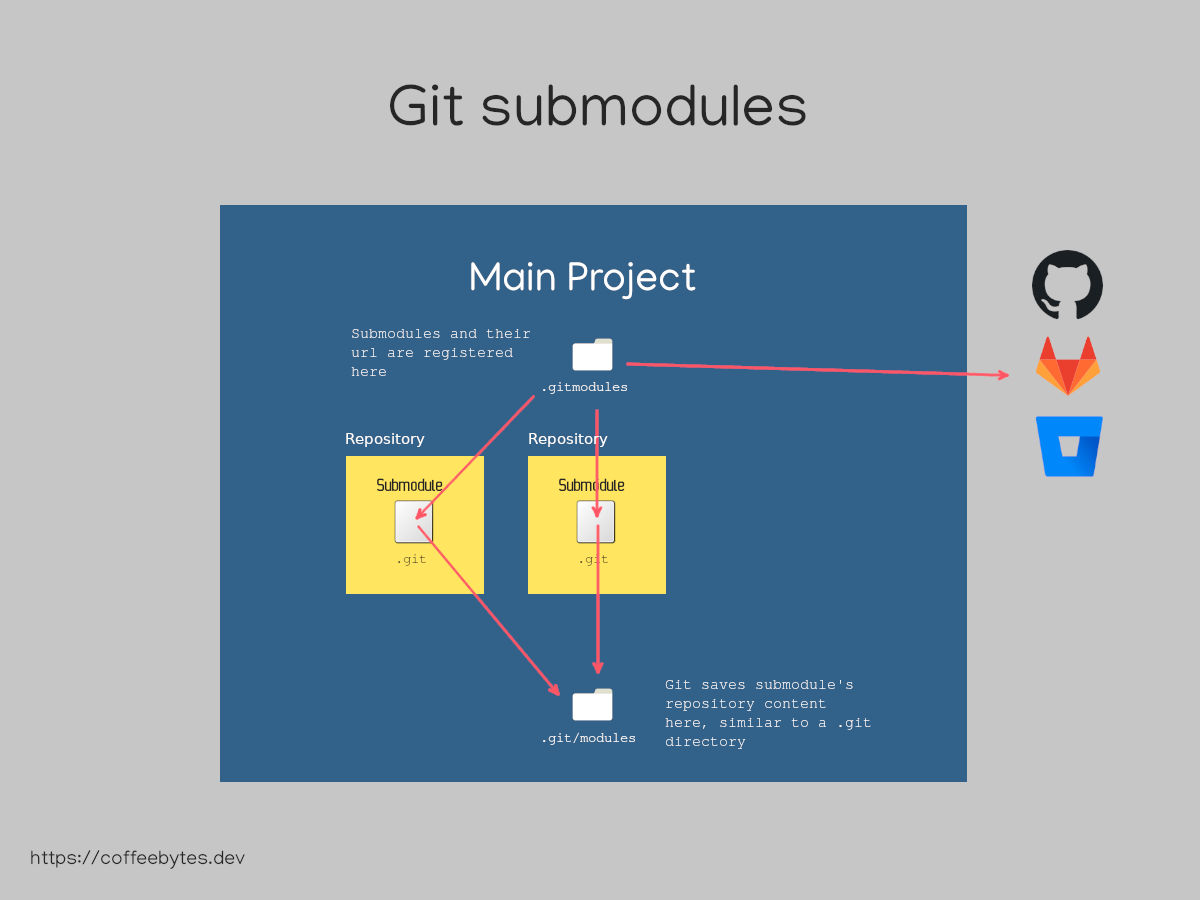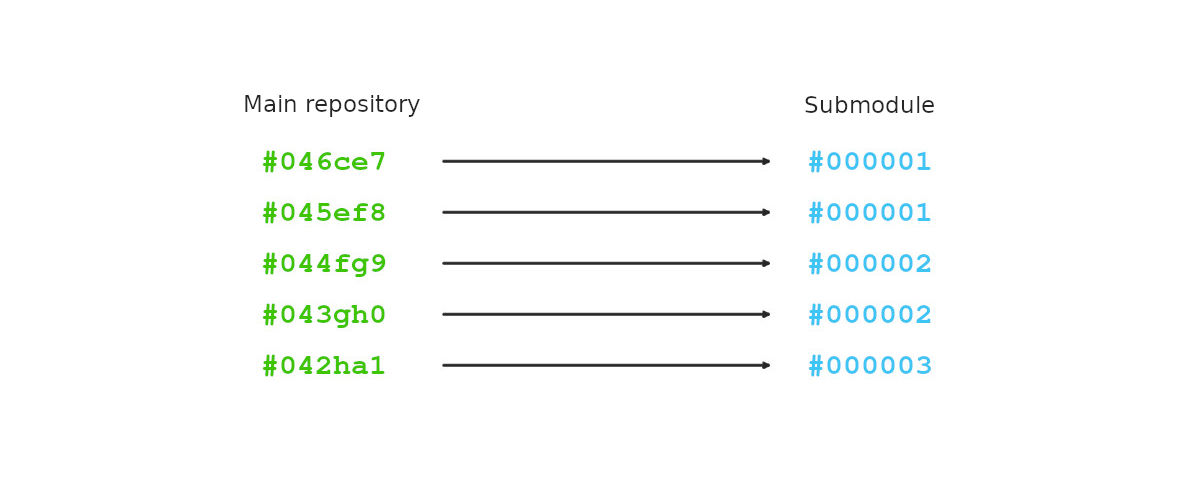Table of contents
Understand How Git Submodules Works and its Workflow
Understand How Git Submodules Works and its Workflow
A git submodule is a record within a git repository that points to a commit in an external repository. They are handled exactly as you would with a repository, they even have a .git file that points to the location where a changelog is kept.

git submodules are useful when we want to incorporate third-party code into a project and at the same time we want to keep strict control of the updates of that code through git. For example:
- A shared repository for a theme or styles (As in SSG, Hugo).
- A third-party library.
- A repository that you want to use to create a Dockerfile in Docker .
On the other hand, using git submodules makes repository management quite complicated if you are not careful or if you work with many submodules, you have to pay attention to the context you are in and remember all the time the repository you are in.
Adding a git submodule to a git repository
To start using a submodule in an existing repository (our main repository) we use the command git submodule add, placing first the url of the submodule and then the folder where we want the submodule to be located.
If the directory does not exist it will be created.
git submodule add <url> <destination>
The above command will copy the url <url> code into the specified <destination> directory.
Structure of a git submodule
After adding a submodule to a repository a new file (not a directory) named .git will be created inside the submodule folder of our repository.
.
├── .gitignore
├── .gitmodules
├── <destination>
│ ├── .git
│ ├── .gitignore
│ ├── app
│ │ ├── files.js
Depending on the repository you choose as a submodule, you will also see its own .gitignore file.
The .gitmodules file
In addition to copying the code from the remote repository into the target folder, git will create a .gitmodules file in the root of our main repository. This file stores the references to the submodule(s) of our repository.
Each of these submodules specifies its path, relative to the repository root, the url and the branch (optional).
[submodule <destination>]
path = <destination>
url = <repository-url>
[branch = <rama>]
This file is important because it is a reference to the submodules that our project needs to work.

The contents of a submodule’s .git file
What does the submodule contain? If you go into any submodule, you will see that it has a file named .git.
cd <destination>
ls -la
.rw-r--r-- 31 user 14 may 09:49 .git
# ...
If you check the contents of this file with the cat command , you will see that it is a path pointing to the .git/modules folder in our main repository. This is how git can keep track of submodules directly in the main repository.
cat .git
gitdir: ../.git/modules/<submodule>
And what’s at that location? In that location are the files with which git manages a repository internally, they keep the same structure as the ones inside the .git folder of your main repository.
Git treats submodules as individual repositories.
A submodule is handled in exactly the same way as a normal repository.
If you run the git status command inside a submodule, you will see that we are inside a different repository than the main one.
git status
on main branch
Your branch is updated with 'origin/main'
# ...
Within the submodule you can perform checkouts, create branches, even commits and pushes. All these changes will be made in the submodule repository, not in the main repository.
Git treats each submodule as if it were a separate repository, so each version of your main repository corresponds to a version of the submodule.
Workflow of git submodules
Every time you make a change within your submodule you must push the changes and then update the reference from the main repository to the submodules.
What happens if you don’t? Well this is where the nightmare of all the people who hate submodules begins, you will be working on the latest version of the submodule, while your colleagues will be working on the old version.
Steps to save changes in a git submodule
How to solve it? With these three steps
- Save the changes (commit) and push them to your submodule.
- Return to your main repository.
- Save the changes (commit) and push to your main repository.
# Modifying submodule
git add <files>
git commit -m "submodule's commit message"
git push
# Returning to your main repository.
cd <main-repository>
# Save the changes (commit) and push to your main repository.
git add .gitmodules <files>
git commit -m "Update to new submodule version"
git push
The important thing to remember here is that we must always update changes to both the submodule and the main repository.
Initializing a repository with a git submodule in git
What if instead of adding a submodule with git add submodule, we clone a project that has a .gitmodules file?
When cloning a repository that has submodules, git clones only the main repository, without including the content of the submodules.
git clone <repo-with-submodules>
Check it, navigate inside the submodule folders and you will see that they are empty.
For git to download the content of the submodules we need to initialize, with –init the submodules with the following command:
git submodule update --init --recursive
The –recursive option will take care of initializing all the submodules of the main repository.
Updating a repository with submodules in git
What if we do a pull of our main project?
As I mentioned to you earlier, each version of your main project corresponds to a version of the submodule, so if the version of your project changed, the submodule it points to may have changed.
Also, in git, submodules are not automatically updated when you update the main repository.
If there were changes in your main repository and you do a git pull it is your obligation to update the submodules up to the most recent commit of the remote submodule code:
git submodule update --recursive --remote
With the above I conclude the article, if you found it useful you can share it in your favorite social networks.







